Commentary provided by:
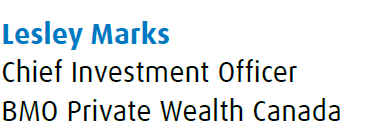
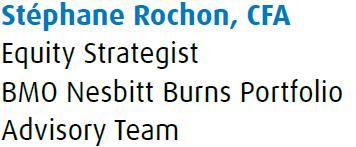

But first reflection
As the holiday season approaches and we bring the first year of this decade to a close, it’s only natural to reflect on the year that ‘was’ or, more appropriately, the year that ‘wasn’t.’ This year brought forward many challenges, as a healthcare crisis emerged with the potential to become a full-blown economic crisis. Companies acted swiftly to mobilize workforces to work from home, parents were tasked with homeschooling their children, families endured sustained periods where they were unable to see loved ones in person, milestones like weddings and graduations were cancelled and, sadly, many confronted the health struggles and loss that came with the onset of COVID-19.
Together, but apart, we united to work towards reducing the impact of the global pandemic as best as we could. While the rise in cases in this second wave is discouraging, optimism for a preventative vaccine provides hope. Despite the difficulties over the past year, markets have generally persevered and looked beyond these hurdles. We expect the second year of this decade to continue with a roar, but it will look a little different than the first year. We believe the driving forces for 2021 will be ‘Recovery, Rotation and Reflation.’ But, first, a bit of retrospective.
Market retrospective
Major indices crossed into positive territory for the year, but that does not come remotely close to telling the market’s full story. A ‘roller coaster’ would be a fitting metaphor or, better still, a ‘bungie jump.’ After a panic sell-off that ravaged equity markets in the first quarter of this year, markets staged a brisk and almost unstoppable recovery for the balance of 2020. The acceleration in risk assets has been spurred by massive fiscal and monetary stimulus which, in turn, revived confidence and led to a solid economic recovery.
Politics took center stage of late, and despite the uncertain outcome, the central narrative has changed from a potential ‘Blue Wave’ to a ‘gridlock’ outcome, where Democrats take the Presidency and the House and Republicans retain control of the Senate. However, this is not a foregone conclusion and we will have to wait until the Georgia runoff elections on January 5 to be certain.
Typically, an administration has the best chance of legislative success when the President’s party holds a majority in both the Senate and House of Representatives. In the case of gridlock, this happens to be a positive scenario for stocks, because Republican Senators have the ability to block or dilute some of the more ‘progressive’ Democratic promises that could impact corporate profits, such as those involving higher corporate and personal taxes, increasing the minimum wage and strengthening environmental, financial and other regulations, among several other proposals.
It is important to underscore that the impact of politics on the markets is generally shorter term in nature and the long-term impact is often overestimated. History has shown that environments with stable or declining interest rates and positive economic momentum have been associated with excellent stock market returns. Interest rates, in particular, have declined considerably in the last year and are likely to only rise modestly, or stay at, or near historically low levels for years to come.
The melt-up in risk assets, including corporate bonds, has continued unabated so far in the fourth quarter of 2020, mostly ignoring the virus’ second wave. Investors’ insatiable demand for higher yielding securities combined with a slower pace of bond issuance was supportive of corporate credit spreads compressing.
Despite the climb in major equity indices, we remain steadfast in our belief that equities offer superior relative value to bonds and; therefore, retain our overweight stance on stocks. Figures 1 and 2 show the relative and historically wide difference between the earnings yield and 10-year bond yields for Canada and the U.S., respectively. These historically wide gaps are one indication of the relative value of stocks when compared with bonds.
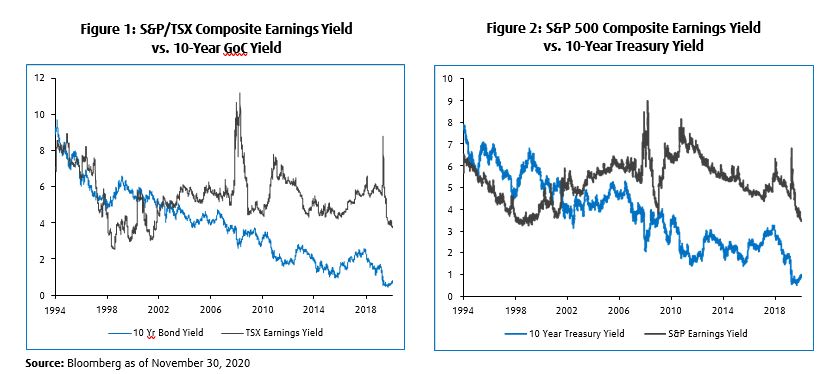
After recession comes recovery
The reboot in the global economy following the first wave of the shutdown is at risk of a setback from the accelerating shutdowns to combat the second wave of COVID-19 cases. However, it is not all doom and gloom as there are bright spots in areas like the Chinese economy, which is showing the rest of the world what life after COVID-19 could be like.
Fortunately for the rest of the world, recent announcements of positive clinical data on several vaccine candidates that are expected to be made available world-wide over the next few months will allow for rapid inoculation. This news promises to help boost the global economy as businesses and consumers will soon be allowed to resume normal activities such as social gatherings, sporting events, travel, restaurant dining and more. The ‘K-shaped’ recovery, where some sectors recovered quickly and others stagnated, will transform to a more unified recovery that resembles more of a ‘V-shape’ as more industries return to normalcy.
Fiscal stimulus has been anchored on income subsidies and support and bridging the gap during the COVID-related shutdowns, but can now pivot towards infrastructure spending. This will provide a further jolt to the economy through job creation over income subsidization.
Economic recovery will lead to earnings recuperation as companies resume normal activities with their customers. Global growth will also broaden out beyond the high secular growth Technology sector, towards cyclical groups such as Consumer Discretionary, Industrials and Financials sectors.
Rotation revival
The trend toward large capitalization growth stocks accelerated for most of the year as investors viewed many of these
companies as 'COVID-beneficiaries.' This created a historically wide valuation disconnect between sectors like Technology
and Financials, and investment styles such as growth versus value (see Figure 3).
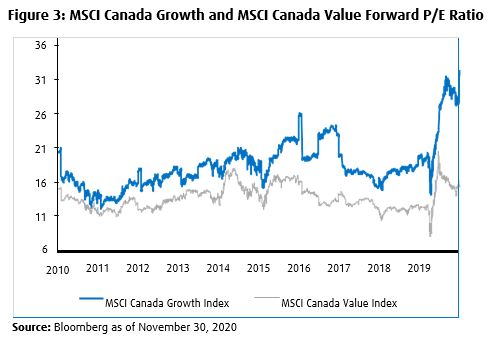
In the final quarter of 2020, the trends that had dominated through most of the year began to wane. Large-cap technology shares and gold companies began to underperform as markets began to price in a potential change in leadership. The growth names that had dominated year to date started to stall out and new leadership emerged, as one by one other sectors participated in the rise in stocks.
The U.S. Presidential election was the first catalyst which signalled the shift, as optimism for infrastructure spending indicated the potential for the economic recovery to widen. Then, as multiple vaccine candidates reported successful trial results, a rapid rotation started, with a change in leadership away from the ‘COVID winners,’ towards some of the hardest hit industries – airlines, cruise ship operators, entertainment and leisure companies. Additional geographies also started to participate in the stock rally of 2020, with European markets surging and leading global equities higher.
We believe that even though many of the secular Technology trends can persist, the sector may lag broader markets due to the impact of fund flows into the previously despondent cyclical companies which are expected to benefit from the reopening of economies. A cyclical recovery, which is likely to emerge in the first half of 2021, will support a continuation of this rotation.
Growth stocks also tend to do well when growth is scarce because they are the only companies that can offer positive earnings growth in an economic slowdown. When growth is more pervasive, such as the early days of positive economic momentum, value sectors tend to outperform.
Low reflation risk
Short-term interest rates will be anchored by the central banks, but medium- and longer-term interest rates could experience a modest gain as fears of inflation with a global economic recovery increases.
We do not expect a major move in rates as high levels of slack in the global economy will offset inflationary risk from the extreme liquidity measures put in place by central bankers and governments to support economies during the global pandemic. Despite a rapid increase in employment levels, we are nowhere near the pre-pandemic levels, creating a large untapped resource that is likely to keep inflation at bay.
Government yields remain near record lows, credit spreads are tight, and yield curves are gradually steepening. These factors taken together do not bode well for expected returns in the short term. More interesting is the fact that government yields have mostly failed to follow the momentum of risk assets higher. Both Canadian and U.S. yields have trended modestly upwards, but are certainly not representative of investors’ enthusiasm towards risk assets. Despite equity indices recovering, and corporate spreads tightening back to pre-pandemic levels, government yields remain lower than where they started the year.
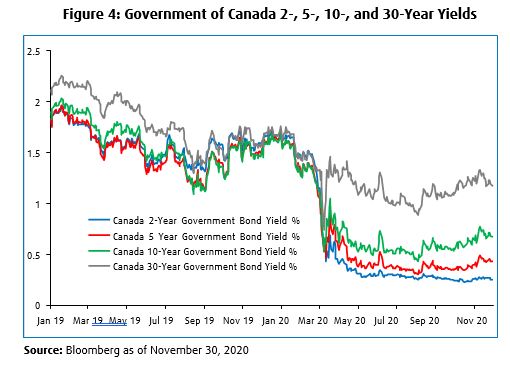
The U.S. Federal Reserve (“Fed”) recently communicated that employment levels will not be a reason to raise interest rates in the future. With over 10 million U.S. jobs yet to be recovered, it is unlikely the U.S. economy will return to pre-pandemic levels of employment before the end of 2021. The Fed also stated a willingness to let inflation run above its 2% target for a period of time. This removes certain longer term or eventual upward pressure on yields and highlights the commitment to keeping short- term rates anchored at low levels for the foreseeable future.
The Bank of Canada (“BoC”) has slowed down the pace of its bond purchases, but has shifted towards purchasing longer-term maturities to better influence borrowing rates that are most important for households and businesses. In its recent rate decision, the BoC reiterated its commitment to extraordinary monetary policy support. Both central banks made it clear that in addition to anchoring short-term rates likely until 2023, asset purchases are here to stay at a minimum through 2021.
So, the combination of economic uncertainty, a slow return to normalcy, and central bank policies, including strong forward guidance, helps explain not only why long-term interest rates have only modestly risen, but why next year’s expectations for higher rates are limited.
Overall, it will be challenging for fixed income investors to repeat this year’s performance and investors will be focussed, more than ever, on improving portfolio returns while maintaining a hedge against equity volatility. Investors may reach for higher yielding alternatives, but this will also impact the risk profile of the capital preservation portion of a portfolio. Yields should remain very low; credit spreads seemingly have limited room to tighten and the yield curve is expected to tilt steeper as the economic momentum takes hold later in 2021.
Finally, despite the tighter credit spreads, we believe that the corporate bond sector will continue to offer relative value, particularly in Canada, and thus we maintain our overweight position in credit.
Conclusion
Our optimism for the future is not without some level of caution. Things rarely go exactly as planned and much of our positivity rests on a smooth global rollout of the COVID-19 vaccine. This will not be without significant distribution challenges that could make the timing of mass vaccinations uncertain.
Although we are optimistic that a change in the U.S. administration will not bring material change to current policies, and may add stability in areas such as geopolitical risk and a reduction in trade tensions from the previous four years, new and unexpected political tussles may emerge.
We must continue to focus on the key market drivers and not the story of the day. Overall, low interest rates with moderate upward pressure, a supportive global central banking system, and an eventual bending of the COVID-19 curve all bode well for risk assets such as global equities and credit.
A challenging holiday season is upon us, as we will be tasked with finding novel ways to celebrate without the usual socializing with friends and family that accompanies the festive season. At the same time, it is likely that the second wave will accelerate the number of cases and place additional strain on healthcare systems around the globe. We remain infinitely grateful for the efforts of the frontline workers in all communities.
Please contact your BMO financial professional if you have any questions or would like to discuss your investments.
Information contained in this publication is based on sources such as issuer reports, statistical services and industry communications, which we believe are reliable but are not represented as accurate or complete. Opinions expressed in this publication are current opinions only and are subject to change. BMO Private Wealth accepts no liability whatsoever for any loss arising from any use of this commentary or its contents. The information, opinions, estimates, projections and other materials contained herein are not to be construed as an offer to sell, a solicitation for or an offer to buy, any products or services referenced herein (including, without limitation, any commodities, securities or other financial instruments), nor shall such information, opinions, estimates, projections and other materials be considered as investment advice, tax advice, a recommendation to enter into any transaction or an assurance or guarantee as to the expected results of any transaction.
You should not act or rely on the information contained in this publication without seeking the advice of an appropriate professional advisor.
BMO Private Wealth is a brand name for a business group consisting of Bank of Montreal and certain of its affiliates in providing private wealth management products and services. Not all products and services are offered by all legal entities within BMO Private Wealth. Banking services are offered through Bank of Montreal. Investment management, wealth planning, tax planning, philanthropy planning services are offered through BMO Nesbitt Burns Inc. and BMO Private Investment Counsel Inc. Estate, trust, and custodial services are offered through BMO Trust Company. Insurance services and products are offered through BMO Estate Insurance Advisory Services Inc., a wholly-owned subsidiary of BMO Nesbitt Burns Inc. BMO Private Wealth legal entities do not offer tax advice. BMO Nesbitt Burns Inc. is a member of the Canadian Investor Protection Fund and the Investment Industry Regulatory Organization of Canada. BMO Trust Company and BMO Bank of Montreal are Members of CDIC.